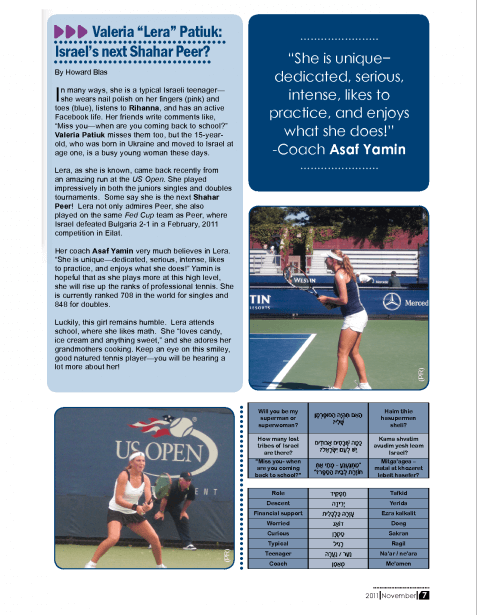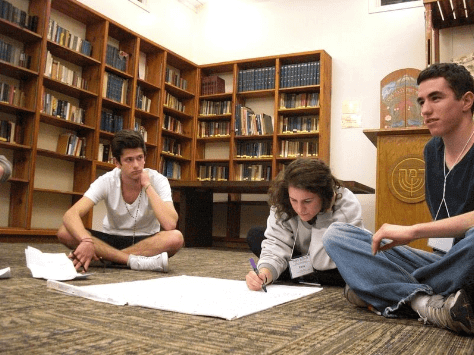Greetings from Camp Ramah in California. In a short while, amitzim counselor, Estie Martin, inclusion counselor, David Cohen, former Tikvah long-time staff member, Shira Arcus, and I will join our colleagues from Ramah special needs programs from across North America to share our various spirited Tikvah prayer services. We have already discussed our inclusion programs, peulot erev, staff week training, Shabbos Is Calling and more! And we presented an hour long peulat erev on “The Role of Special Needs In Ramah Camping. We are lucky enough to participate in four intense days of meetings and sharing as part of Reshet, a National Ramah Commission initiative to bring together staff members from the various Ramah special needs programs which include Tikvah, Breira and Ramah family camps. Four of our special needs program directors are also here. We are pleased to join Ramah rashei edah, Daber Fellows, camp directors, and participants in Ramah Service Corps and the Weinstein Institute for meetings and fun. We look to sharing more from our Ramah Ojai experience–perhaps after our visit to the beach today!
An Open Letter to the Mishlochot: The Special Tikvah/Mishlochot Relationship
Thank you to so many of our mishlochot friends who came from all over Israel to visit with our Tikvah Ramah Israel Program participants during our recent Israel trip. Thank you for hosting us in your homes in Beit Shemesh and Modiin. Thanks for taking us swimming and making us a beautiful picnic lunch in Caesarea. Thanks for traveling from Rishon Lezion and other places to the Palmach Museum in Tel Aviv for a visit during our short lunch break. Thanks for hanging out with us at the Robinson’s Arch, the Kotel, the Jewish Quarter and on the midrachov in Jerusalem.
Yes, it is wonderful seeing the important sites of Israel. But it is the people of Israel who make Israel truly come alive! You come to camp as shlichim and bring Israel to us; you return to Israel with a new understanding and appreciation of people with disabilities–and so many abilities. Please continue your work as shichimi on behalf of attitude change toward people with special needs. Keep up the great work! We are so appreciative to all of you.
Music, peace, and the future
Original Article Published on The Jerusalem Post
A D’’ash exclusive with singers Idan Raichel and India Arie
For the past 10 years, Idan Raichel has been one of Israel’s most popular, unique and beloved musicians. Unlike most band leaders who stand at the center of the stage, Idan, with his long dreadlocks, thick hair band and baggy pants, sits at his keyboard at the far left of his stage. In extensive tours of Israel and the world, the composer and director prefers to showcase his enchanting blend of musicians – from various countries in African, Latin America and the Caribbean – and their unique sounds.
As the director of the Idan Raichel Project, the 34-year-old from Kfar Saba shares a message of tolerance and love. He has changed the face of Israeli music. Idan Raichel has grown from being a nine-year-old accordion player to an Israeli Army Band musician, to a counselor at a boarding school for immigrants and troubled youth, to the leader of the always evolving Idan Raichel Project, which has so far released three platinum albums.
Now, Idan Raichel is composing music with India Arie, the famous African-American singer songwriter who has sold more than 10 million albums worldwide and won four Grammy Awards.
Raichel and Arie performed their song, ‘Gift of Acceptance’ at last year’s Nobel Peace Prize awards. The pair will release their new album, called Open Door, album in March 2012.
D’’ash reporter Howard Blas caught up with India and Idan following their concert at New York City’s Beacon Theater.
D’’ASH: When did you guys first meet?
India: I was traveling in Israel in 2008 and was exploring historical sites. I left the tour early and went down to Tel Aviv. I like to explore the music traditions and the populations of a place. I asked people “who are the forward thinking people with intelligent lyrics?” Everyone said “Idan Raichel,” so I arranged to meet him.
Idan: I am a big fan of India’s. I was very happy such an established American artist is so open-minded to explore music from other parts of the world. When she came to Israel, it was a really cool dream to have an American singer singing with us in English. I realized there was good chemistry between us so we wrote a whole album together.
D’’ASH: What attracts you to each other?
Idan: India is very modest and artistic, and she has a lot of confidence. Sometimes in art and hip hop culture, there are a lot of sexy elements. India presents herself in a very modest way with a lot of grace. It is beautiful to see.
India: We just have very similar musical tastes. When I hear his chord progression and melodies, I like it, but even more, I feel it is something I should be singing. I love his music and relate to it and want to sing it. That happens rarely!
D’’ASH: Your New York concert took place the the very same day Gilad Shalit was released. What was your reaction when you heard that he was home? Tell us about your hopes and dreams for the Middle East.
Idan: It is a new year in Israel. I hope it will be a year of building foundations for peace. I hope that all prisoners who went back to their side and Gilad Shalit, who came to our side, will represent a movement for fighting for peace and not wars.
India: Idan first told me the story of Gilad Shalit when I went to Israel in September, 2010. I don’t know enough about Gilad Shalit and his situation. But it is always beautiful to see someone survive. I hope the prisoners released will commit to peace. It was interesting to be up close with three Israeli musicians from Idan’s band and see how they felt. It was very moving to hear them debating. All had different points of view about the prisoners being released. In the end, they were happy about the release; whatever their previous beliefs had been, they were all happy he was out.
D’’ASH: Can you describe the message of your song ‘Gift of Acceptance?’ What what was it like performing it at the Nobel Prize ceremony?
Idan: The melody I had in Israel for the past three or four years.
I sent it to India and she wrote beautiful lyrics. It was everything she wanted to say until now and couldn’t say it, until today. “Gift of Acceptance’ turned out to be one of the most beautiful songs on Open Door. The song represents the idea that people all over the world, regardless of race, gender, and political views, can join together and become a big community.
India: It was satisfying and fun and not only because it was at such a prestigious event. My whole life, I have been committed to making music in the name of peace. It was fulfilling to be there and to be singing a song I feel passionate about! It is aligned with my values.
D’’ASH: What was your funniest moment on tour?
Idan: To go on stage and start to say, “Good Evening New York, or LA, or Denver” and then pause and realize you don’t even know where you are!
India: At our last show of the tour, we were playing Open Door music. There is one part where I sing a song in three part harmony with my back up singers (we sing like sisters!) Anyway, during the show, Idan and Gilad and Yankele (his musicians) surprised me. They suddenly came out from backstage with one microphone, pretending to do the three part harmony. It was terrible!
D’’ASH: What advice can you give to young musicians?
Idan: Do it in YOUR way; follow your own dreams and inspirations. Learn from the past to build your own foundations for what you want to do in the future.
India: Know that you have to do what you love. Sometimes you do what you THINK will make money or will be popular. When you do what you really love, things fall in to place in a special way.
Valeria aeuroeleraaeur Patiuk: Israel Ertms next Shahar Peer?
Original Article Published on The Jerusalem Post
In many ways, she is a typical Israeli teenager she wears nail polish on her fingers (pink) and toes (blue), listens to Rihanna, and has an active Facebook life. Her friends write comments like, Miss you when are you coming back to school? Valeria Patiuk misses them too, but the 15-year-old, who was born in Ukraine and moved to Israel at age one, is a busy young woman these days.
Lera, as she is known, came back recently from an amazing run at the US Open. She played impressively in both the juniors singles and doubles tournaments. Some say she is the next Shahar Peer! Lera not only admires Peer, she also played on the same Fed Cup team as Peer, where Israel defeated Bulgaria 2-1 in a February, 2011 competition in Eilat.
Her coach Asaf Yamin very much believes in Lera. She is unique dedicated, serious, intense, likes to practice, and enjoys what she does! Yamin is hopeful that as she plays more at this high level, she will rise up the ranks of professional tennis. She is currently ranked 708 in the world for singles and 848 for doubles.

Luckily, this girl remains humble. Lera attends school, where she likes math. She loves candy, ice cream and anything sweet, and she adores her grandmother’s cooking. Keep an eye on this smiley, good natured tennis player you will be hearing a lot more about her!









